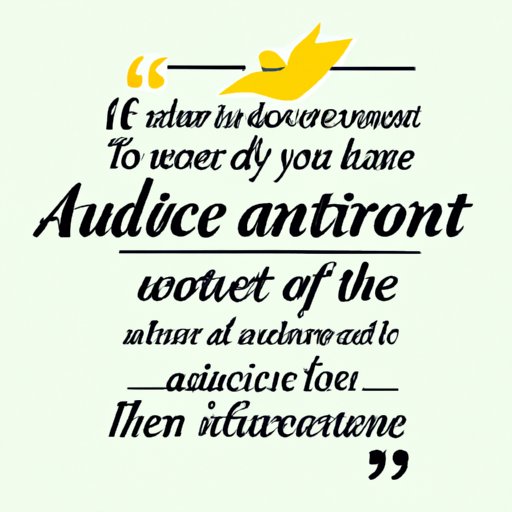
I. Introduction
Using quotes in writing is an essential aspect of effective communication. Quotes can help to provide additional context and credibility to your writing, which can be the difference between making a compelling argument or falling flat. In this article, we’ll be exploring how to introduce a quote in a manner that is both seamless and informative.
II. Definition and Types of Quotes
Before diving into how to introduce a quote, it’s important to define what it is and the different types of quotes available.
A quote is a direct or indirect reference to a specific piece of work, such as a book, article, or speech. There are two main types of quotes: direct and indirect. A direct quote is an exact, word-for-word transcription of the original text. An indirect quote, also known as a paraphrase, is a restatement of the original text using different words.
Direct quotes are used when the original language is particularly striking or effective, or when it’s important to provide exact wording for context. Indirect quotes, on the other hand, can be useful when summarizing large amounts of text or when you want to rephrase an author’s ideas in your own words.
III. How Quotes Enhance Context
Quotes can help to enhance the context of your writing, providing additional insights for your reader. For example, a quote can add a unique perspective or insight to a topic, or it can provide evidence and support for a claim you are making.
Quotes can also be used to demonstrate the author’s opinion or voice on a particular issue, which can add credibility to your own arguments. By using quotes from experts in the field, you can bolster your arguments with research and statistics.
IV. Importance of Using the Author’s Name
When introducing a quote, it’s essential to name the author of the original text. This not only gives credit to the original author but also emphasizes the credibility of the quote. Additionally, citing the author of the quote can help readers to locate the original source and learn more about the context of the quote.
Author attribution is crucial in any writing, but it’s especially important in academic writing. Proper attribution shows that you have done your research and have a deep understanding of the literature in your field.
V. Transitioning to a Quote
Transitioning from your prose into a quote can be challenging, but it’s essential to maintain the flow of your writing. One way to do this is to use a signal phrase to introduce your quote. A signal phrase is a phrase that alerts the reader that a quote is coming.
Examples of signal phrases include:
- “According to [author name],”
- “In [author name]’s words,”
- “As [author name] puts it,”
Using these phrases can help to create a smooth transition from your writing into a quote. Additionally, it’s important to ensure that your quote fits seamlessly within the overall structure and style of your writing.
VI. Citation and Attribution
When introducing a quote, it’s essential to provide proper citation and attribution. This not only gives credit to the original author but also helps readers to locate the original source of the quote.
Citation styles vary depending on the type of writing and the intended audience. In academic writing, the most common citation styles are APA and MLA. It’s essential to follow the specific guidelines for the citation style you are using to ensure that you are providing accurate and proper attribution.
VII. Examples of Successful Quotes in Popular Media
One of the best ways to understand the impact of a quote is to analyze successful quotes in popular media. Consider the famous quote from Martin Luther King Jr., “I have a dream.” This quote is an excellent example of how a few simple words can carry immense weight. The quote communicates a particular vision and provides vivid imagery that stays with people long after they’ve heard it.
Another example is “I am not a crook” by President Richard Nixon during his presidency. The quote became juxtaposed with the growing Watergate scandal and served as a cause for the demise of Nixon’s political career. The quote illustrates how quotes can also backfire in certain circumstances and the importance of using them appropriately.
VIII. Conclusion
In conclusion, introducing quotes in writing is essential for creating effective and compelling communication. Whether you’re using quotes to provide context, evidence, or support, it’s critical to do so seamlessly and accurately. By following the tips outlined in this article, you can master the art of introducing quotes. We encourage you to practice these tips in your future writing and see the impact they can have on your message.




